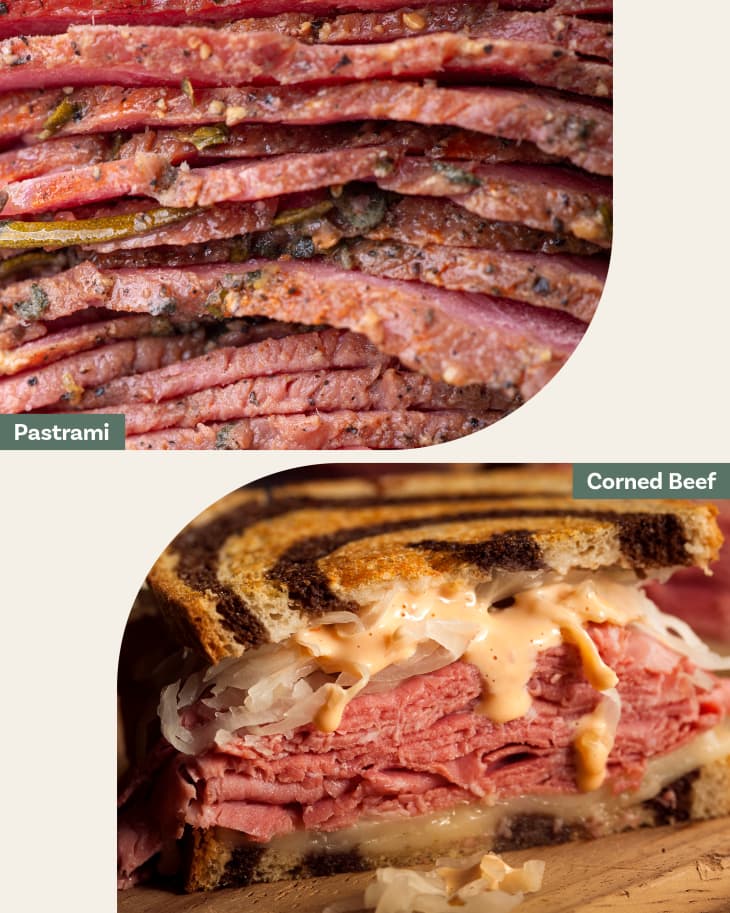What’s the Difference Between Pastrami and Corned Beef?
Where I live, in Richmond, Virginia, we hold claim to one of the greatest deli sandwiches of all time: The Sailor, a gut-busting combination of hot pastrami, grilled knackwurst, Swiss cheese, and mustard piled between two pieces of rye bread. It’s the kind of sandwich that must be served with a pickle and followed by a long nap, much like its cousins (hot pastrami on rye and the Reuben, which features corned beef in the starring role). All this cured meat crossover got me curious about the difference between pastrami and corned beef. Here’s what I found out.
What’s the Difference Between Pastrami and Corned Beef?
Pastrami and corned beef are similar, but their differences lie mainly in their preparations.
- Corned beef is made from beef brisket that’s brined in salt and pickling spices (like bay leaves, mustard seeds, and peppercorns) and then boiled.
- Pastrami is made from one of several cuts of beef, including brisket or the navel or deckle cuts. After being brined and boiled, pastrami is then rubbed with a mix of spices before being cooked again, often smoked for a day or more, and finally steamed before serving.
Does Pastrami Taste Like Corned Beef?
In terms of flavor, it’s fair to say that pastrami and corned beef have distinguishable tastes. Both are salty, thanks to their time in the brine, but corned beef combines that saltiness with a subtle sour note and a salami-esque flavor, whereas pastrami is all about the smoke and spice. The hours over a wood fire and the extra rub of seasonings comes through to create something more complex — rich, smoky, and satisfying.
What Are the Origins of Pastrami and Corned Beef?
The origins of both pastrami and corned beef are immigrant stories, and neither dish originally featured beef. Pastrami dates back to the Ottoman Turks, who brined their meat to preserve it and then rubbed it with spices.
According to a text accompanying a 2012/13 New York Public Library Exhibition, pastrami became a fixture in Romania, where it was known as pastirma or pastramă and where goose was the meat of choice. Romanian immigrants brought pastrami with them to the U.S. in the early 20th century, and they discovered beef was more plentiful than goose, so they adapted the recipe to feature beef instead.
Similarly, Irish immigrants brought the process of “corning”, which refers to the large grains of salt originally used in the brine, with them to the U.S. In Gaelic Ireland, cows were revered as almost sacred creatures, and they were primarily used for work, not meat. Only the wealthiest Irish would have dined on beef, whereas the masses, and the Irish immigrants who came to the U.S., would have primarily eaten pork. When Irish immigrants arrived in the States, they too found beef to be more widely available, so they adapted the method to that protein.
How Are Pastrami and Corned Beef Served?
The most common way we think of eating pastrami today is on a hot pastrami on rye with mustard (and a pickle on the side). This has been a stalwart of Jewish delis for the past 100 years.
You’ll also find a Reuben sandwich on the menu at many delis. That sandwich is composed of corned beef, Swiss cheese, sauerkraut, and Russian or Thousand Island dressing on rye. Alternatively, a Reuben made with turkey is called a Rachel. Unlike a hot pastrami, a Reuben sandwich is not considered kosher because it combines meat and cheese.
In a full-circle moment for pastrami, the term has evolved to once again refer to a method and flavor rather than a specific cut of beef, with a proliferation of non-beef pastrami products on the market, including pastrami-spiced turkey, pastrami-cured salmon, pastrami-seasoned bacon, and pastrami chips.
Corned beef is also common in a hash, made with potatoes and onions, and corned beef and cabbage are now considered the most iconic food with which to celebrate St. Patrick’s Day.
